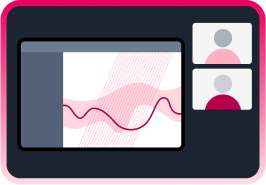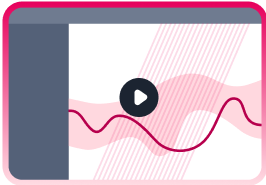What's Covered:
What are heatmaps? What is a website heatmap used for?
Heatmaps are graphical or visual representations of data where values are denoted by color. With heatmaps, teams can visualize data at a glance to better understand how users click, scroll, and navigate through a website.
Heatmaps are a crucial tool for analyzing user experience and usability. They help teams understand where people are getting stuck and where they focus their attention, as well as what elements appeal most to the user base.
While tools like Google Analytics can assist teams with identifying which pages are experiencing issues, heatmaps help teams to close the understanding gap by identifying the elements that are causing the biggest headache for users. Analytics alone can’t explain where people get confused or frustrated.
Many organizations pair heatmaps with session recording (or user replay) technology so that teams can better understand how specific, individual users interacted with the product. Without the help of other tools, heatmaps only tell you WHAT happened. Heatmaps alone cannot tell you WHY something happened.
For heatmapping, having large amounts of quantitative and qualitative data is crucial. Unlike anomaly detection, heatmaps focus on what the average user experiences. Because of this, heatmaps are useful for teams looking to enhance their A/B testing strategy.
Desktop and mobile heatmaps give teams a cross channel approach to understanding how users interact with products across an organization’s digital portfolio.
The area above the fold (the term used to describe the parts of a webpage that users do not need to scroll to see) is significantly smaller on mobile devices than desktop ones. Heatmaps allow teams to quickly evaluate and understand how these differences impact the user experience, micro conversions, and more.
Heatmap Visualization and Analytics
In general, heatmaps use a warm-to-cool color spectrum: Colors like red and orange signify heavy usage, whereas colors like blue and green indicate lower levels of interactions. Other heatmaps scale from light to dark, with the darkest spots indicating the heaviest amount of user behavior.
Visualizing website and app user behavior helps teams to spot issues, identify opportunities, monitor trends, and optimize further.
Benefits of using heatmaps in your analytics strategy
Using heatmaps can benefit your organization in a number of ways. They can help your organization answer crucial questions, such as:
- Are people seeing important content?
- Are people finding the page’s main links, buttons, and CTAs?
- Are people getting distracted by, or rage clicking on, non-clickable elements that do not lead to micro conversions?
- What issues are people encountering across the organization’s digital portfolio?
Who uses heatmaps? Who are heatmaps for?
UX designers, developers, IT/Ops professionals, marketers, sales teams, customer support specialists and other stakeholders can benefit from using heatmaps.
In particular, UX designers use heatmaps and other qualitative analytic tools to understand the best way to place elements in the user experience’s visual hierarchy.
Types of heatmaps
Some common examples of heatmaps include:
- Scroll maps, which show how far users scroll down a page on a desktop, mobile, or tablet device. Scroll maps reveal the most and least viewed parts of the page.
- Click maps, which reveal where users click their mouse on a desktop computer or tap their screen on mobile/tablet devices. Click maps help organizations analyze how users interact with the page itself, especially buttons, links, & images. For example, click maps can help teams to identify rage clicks, which occur when customers repeatedly click on an element that’s not functioning as they expect. Rage clicks general signal user friction and frustration.
- Move maps, which show how people navigate the mouse or cursor through a specific page. While mouse movements can’t tell us exactly where users are looking, there is a strong correlation between where the mouse is and where people are looking.
Heatmap software and tools
Some common heatmap software and tools include:







